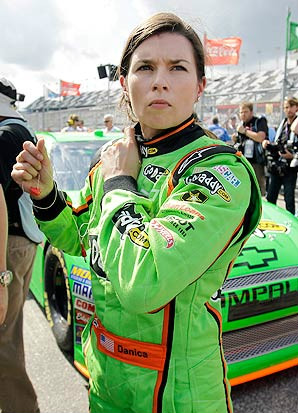
Why all eyes will be on Danica Patrick during the Daytona 500
That's what makes Danica Patrick's start in Sunday's Daytona 500 so significant. For the first time since Janet Guthrie was breaking gender barriers in the late 1970s, a female driver is coming to Daytona with a legitimate chance to run well and, with a few good breaks, perhaps even win the most prestigious event in all of stock car racing.
At most tracks, it would be ludicrous to suggest that a NASCAR newcomer could come in and win right away. But the style of racing at Daytona, where drivers are dependent on forming drafting partnerships with other drivers, dilutes the need for a vast amount of experience. If 20-year-old Trevor Bayne could win last year's Daytona 500 in his first Daytona start, then why can't Patrick -- with more than a decade of competitive racing behind her -- do the same?
Skeptics will point out that most of Patrick's racing résumé has been written on the open-wheel IndyCar circuit, which is a distant cousin to the type of racing found in NASCAR. Several drivers who have accomplished far more than she has in open-wheel racing still were unable to make a successful transition to stock cars (Hello, Dario Franchitti). Many of the questions surrounding Patrick's ability to succeed in NASCAR have less to do with her gender and more to do with whether she can adjust to the change in racing style.
Still, there is no doubt that Patrick's gender is the driving force behind all the attention she has received in the weeks leading up to Sunday's race. She is not the first woman to step into this boys club, but she undoubtedly is the most famous. And that is perhaps the primary reason that this year's Daytona 500 is taking the sport to a different level.
The closest comparison is Guthrie's foray into NASCAR and IndyCar racing 35 years ago, which was certainly huge news at the time. She finished 12th in the 1977 Daytona 500 and ninth the following year in the Indianapolis 500, and her success briefly rekindled interest in female racers. Only one woman started a NASCAR Cup-level event in the 20 seasons from 1956 through 1975. Three women, including Guthrie, made Cup starts in the 1977 season alone.
But Guthrie's time in the racing spotlight was short-lived. She was out of the sport by the early 1980s, competing in a total of only 33 NASCAR races and 11 IndyCar events. While she was undoubtedly a pioneer for female racers, her accomplishments did not translate into any long-term success for other women in the sport.
Things changed dramatically in 2005 when Patrick finished fourth in the Indy 500 as a series rookie, breaking Guthrie's mark for the best finish in the race by a woman. The record-setting run landed Patrick on the cover of Sports Illustrated under the headline, "The Start Of Something Big."
In the years since then she has had some quality moments on the racetrack, highlighted by her only IndyCar victory in 2008 in Japan. She also had a third place showing in the 2009 Indy 500 and finished fourth last year in the Nationwide Series race at Las Vegas Motor Speedway, the best finish ever by a woman in one of NASCAR's three national series. But for the most part, Patrick's overall racing career has been only slightly above average. Combine her stats with the fact she isn't the first woman to ever compete in the Daytona 500, and some might wonder why it is such a big deal.
Other than perhaps Dale Earnhardt Jr., nobody in NASCAR is a bigger celebrity than Patrick. Not five-time champion Jimmie Johnson, not Jeff Gordon, not reigning champion Tony Stewart. She has used her attractiveness -- Patrick recently said she prefers the term "pretty" to "sexy" -- to promote herself through numerous magazine photo shoots and, most notoriously, the racy GoDaddy commercials that have become a regular part of televised sports coverage.
Do not underestimate the impact the GoDaddy ads have had on Patrick's popularity. She initially became well-known because of her racing ability, but she became a celebrity because of her looks and her willingness to use those looks to her advantage. Since 2007, Patrick has appeared in 10 GoDaddy commercials during the Super Bowl. People who know nothing about auto racing now know about Patrick. She has become a marketing maven, and that makes her appearance in the Daytona 500 more eventful than if Sarah Fisher or another female driver were in the lineup.
"I think she is great for our sport," Johnson said earlier this month. "We need people tuned in and watching, and certainly new fans are important to all of us. She brings in a lot of new fans and she has a big following. She's been able to get our sport onto a different platform, with mainstream media and things that she is involved with outside of racing. I'm excited for it. I think it is going to be great."




